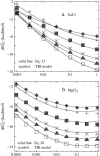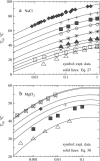Nucleic acid helix stability: effects of salt concentration, cation valence and size, and chain length
- PMID: 16299077
- PMCID: PMC1367269
- DOI: 10.1529/biophysj.105.070904
Nucleic acid helix stability: effects of salt concentration, cation valence and size, and chain length
Abstract
Metal ions play crucial roles in thermal stability and folding kinetics of nucleic acids. For ions (especially multivalent ions) in the close vicinity of nucleic acid surface, interion correlations and ion-binding mode fluctuations may be important. Poisson-Boltzmann theory ignores these effects whereas the recently developed tightly bound ion (TBI) theory explicitly accounts for these effects. Extensive experimental data demonstrate that the TBI theory gives improved predictions for multivalent ions (e.g., Mg2+) than the Poisson-Boltzmann theory. In this study, we use the TBI theory to investigate how the metal ions affect the folding stability of B-DNA helices. We quantitatively evaluate the effects of ion concentration, ion size and valence, and helix length on the helix stability. Moreover, we derive practically useful analytical formulas for the thermodynamic parameters as functions of finite helix length, ion type, and ion concentration. We find that the helix stability is additive for high ion concentration and long helix and nonadditive for low ion concentration and short helix. All these results are tested against and supported by extensive experimental data.
Figures









Similar articles
-
Ion-mediated nucleic acid helix-helix interactions.Biophys J. 2006 Jul 15;91(2):518-36. doi: 10.1529/biophysj.106.084285. Epub 2006 Apr 28. Biophys J. 2006. PMID: 16648172 Free PMC article.
-
RNA helix stability in mixed Na+/Mg2+ solution.Biophys J. 2007 May 15;92(10):3615-32. doi: 10.1529/biophysj.106.100388. Epub 2007 Feb 26. Biophys J. 2007. PMID: 17325014 Free PMC article.
-
Quantitative analysis of the ion-dependent folding stability of DNA triplexes.Phys Biol. 2011 Dec;8(6):066006. doi: 10.1088/1478-3975/8/6/066006. Epub 2011 Nov 9. Phys Biol. 2011. PMID: 22067830 Free PMC article.
-
Importance of diffuse metal ion binding to RNA.Met Ions Life Sci. 2011;9:101-24. Met Ions Life Sci. 2011. PMID: 22010269 Free PMC article. Review.
-
Understanding nucleic acid-ion interactions.Annu Rev Biochem. 2014;83:813-41. doi: 10.1146/annurev-biochem-060409-092720. Epub 2014 Mar 5. Annu Rev Biochem. 2014. PMID: 24606136 Free PMC article. Review.
Cited by
-
Chloride Enhances DNA Reactivity with Chlorine under Conditions Relevant to Water Treatment.Environ Sci Technol. 2022 Sep 20;56(18):13347-13356. doi: 10.1021/acs.est.2c03267. Epub 2022 Aug 26. Environ Sci Technol. 2022. PMID: 36027047 Free PMC article.
-
Determination of base binding strength and base stacking interaction of DNA duplex using atomic force microscope.Sci Rep. 2015 Mar 16;5:9143. doi: 10.1038/srep09143. Sci Rep. 2015. PMID: 25772017 Free PMC article.
-
DNA Antiadhesive Layer for Reusable Plasmonic Sensors: Nanostructure Pitch Effect.ACS Omega. 2022 Aug 30;7(36):31682-31690. doi: 10.1021/acsomega.2c01370. eCollection 2022 Sep 13. ACS Omega. 2022. PMID: 36120011 Free PMC article.
-
Improved nearest-neighbor parameters for the stability of RNA/DNA hybrids under a physiological condition.Nucleic Acids Res. 2020 Dec 2;48(21):12042-12054. doi: 10.1093/nar/gkaa572. Nucleic Acids Res. 2020. PMID: 32663294 Free PMC article.
-
TBI server: a web server for predicting ion effects in RNA folding.PLoS One. 2015 Mar 23;10(3):e0119705. doi: 10.1371/journal.pone.0119705. eCollection 2015. PLoS One. 2015. PMID: 25798933 Free PMC article.
References
-
- Tinoco, I., and C. Bustamante. 1999. How RNA folds. J. Mol. Biol. 293:271–281. - PubMed
-
- Woodson, S. A. 2005. Metal ions and RNA folding: a highly charged topic with a dynamic future. Curr. Opin. Chem. Biol. 9:104–109. - PubMed
-
- Draper, D. E., D. Grilley, and A. M. Soto. 2005. Ions and RNA folding. Annu. Rev. Biophys. Biomol. Struct. 34:221–243. - PubMed
-
- Sosnick, T. R., and T. Pan. 2003. RNA folding: models and perspectives. Curr. Opin. Struct. Biol. 13:309–316. - PubMed
Publication types
MeSH terms
Substances
Grants and funding
LinkOut - more resources
Full Text Sources
Other Literature Sources

